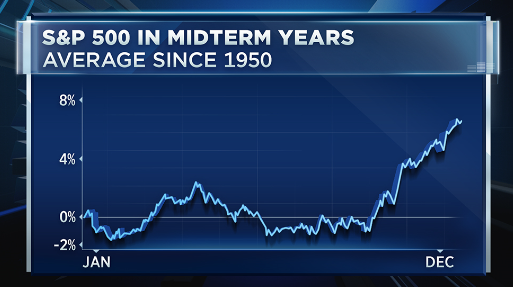The capital markets are bracing themselves for what could be a raucous ride that investors were accustomed to during the more volatile month of October–a stark contrast to the Tuesday morning session as the markets were muted as voters head to the polls for midterm elections.
As of 10:45 a.m. ET, the Dow Jones Industrial Average was up over 60 points, the Nasdaq Composite gained 40 points and the S&P 500 ticked eight points higher. Mylan N.V. was the biggest gainer in stocks, rising 13% on third quarter earnings despite missing sales expectations.
As the majority of the markets take a wait-and-see approach, analysts were echoing the general consensus of political pundits that the Democrats will win the House of Representatives, while the Republicans hold down the Senate–an invitation for gridlock that’s not essentially a bad thing for the markets, according to Bank of America Merrill Lynch analysts.
“Markets generally do well under gridlock,” noted Bank of America Merrill Lynch analysts. “A modest infrastructure bill might see bipartisan support, which could lift Industrials and Materials. A Republican sweep could be equally positive for the overall market as gridlock, as a coordinated Congress could move to enact pro-growth measures. These could include another round of individual tax cuts, or making select tax cuts permanent. … Meanwhile, a Democratic sweep could increase the risk of congressional investigations. And while this scenario is currently not on the table, in the event of impeachment proceedings, it could be classified as an exogenous macro ‘shock.'”
Post Midterm Election Rally Imminent
There are never any sure things when it comes to the markets, but if history is correct, there’s one thing to bank and that’s a post midterm election stock rally. According to Stephen McBride of the RiskHedge Report, it could bode well for stocks and in turn, three exchange-traded funds (ETFs).
As McBride noted in a MarketWatch article, stock movements into the green are a perfect 18-for-18 following midterm elections–the type of sure-shot accuracy that could rival even basketball star Stephen Curry from the three-point line.
“Since 1946, there have been 18 midterm elections. Stocks were higher 12 months after every single one. Every single one,” McBride wrote. “That’s 18 for 18. Even though we’ve had every possible political combination in the past 72 years. Republican president with Democratic Congress. Democratic president with Republican Congress. Republican president and Congress. Democratic president and Congress.”
Related: Dow Stumbles as U.S.-China Trade Talks Stall
The accuracy of a rally is notable, but also its extent as McBride cited that following midterm elections, stocks have gone up by an average of 17% and even higher from their lows–32%. McBride also alluded to the latest October sell-off as standard fare when reacting as a precursor to midterm elections.
“There’s one last important point you should know,” wrote McBride. “Leading up to midterms, U.S. stocks typically perform poorly. From January to October in midterm years, they drop an average of roughly 1%. In all other years, stocks rise roughly 7% in that time frame.”
CNBC underscored this point regarding the S&P 500 index in particular in the chart below:

In order to capture the subsequent run up in stocks, investors may want to consider three ETFs that track the S&P 500 to take advantage of the post-midterm election gain. Investors are hoping a rise in U.S. equities for a 19th consecutive time are in store, which is a much-needed break after October’s volatility.
“While parsing out the likely election outcomes and looking back for historical precedents does not lead to particularly clear conclusions (in part because of small sample sizes), the most robust result we have found is that economic, fundamental and market outcomes tend to improve in the two years following a mid-term election, without regard to President or party,” noted investment firm Bernstein.
For more real estate trends, visit ETFTrends.com
